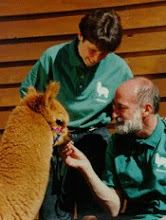Here are some tips to make sure your alpaca experience is splendid:
1) Contact the Alpaca Registry, Inc. (ARI) and let them know you are a brand new alpaca owner. They can walk you through some of the basics of alpaca ownership. Most importantly, you will want to get a herd code (ARI will assign one) and transfer your new alpacas to it. Transferring is often the responsibility of the buyer. For many reasons, including the IRS tax code, you will want your name to show up as the "owner of record" with ARI.
To learn more, visit the ARI website: www.alpacaregistry.com.
Make sure to take a look at ariACADEMY, a free online library of alpaca articles, videos and other resources.
2) Contact the Alpaca Owners and Breeders Association, AOBA, and join at either the farm or associate member level. Joining at the farm level will get you a subscription to Alpacas Magazine, the official journal of the North American alpaca industry. Joining at any level means your name will show up in membership directories and you will receive the AOBA newsletter as well as emails about events and actions that could be of benefit to you. Visit the website www.alpacainfo.com to find out more.
3) Contact local veterinarians and find one that you feel comfortable with, hopefully one with alpaca or llama experience. If none of your local vets have alpaca or llama experience, find one with sheep or goat experience. Discuss how the vet prefers to handle things. For example, does he or she make ranch visits? How much do they charge? Will they come for one alpaca, or do you need to coordinate ranch calls when you have several procedures to take care of? The more you understand about your vet's expectations, the better, and vice versa.
4) Contact local hay growers and secure a source of hay. Drought and other climate issues can make hay difficult to find some years. Alpacas need less protein than some other animals -- plain old grass hay is best. Small bales are likely the easiest to store and move for most alpaca farmers, but nowadays many hay growers put up hay in giant round bales that require special equipment to move. It is best to find a good source of small bale grass hay and buy as much as you can ahead of when you will need it. You will also need a place to store the hay you buy - hay storage should be in a dry, cool, protected area.
5) Contact local alpaca breeders and find one or more you can talk to easily. Raising livestock takes a lot of time and energy. Your compadres will be a source of inspiration, can assist with shearing or ranch-sitting (for your soon-to-be-rare vacations away from home), and can lend a hand and helpful advice in case of emergency. The sooner you get to know them, the better.
6) Purchase supplies. You will need good-quality halters designed for alpacas plus lead ropes, a few basic medications, wormers, emergency first aid supplies, a cria delivery kit, toenail clippers, buckets and feeders, loose mineral mixes and a restraining chute. We recommend every new owner put the book "Caring for Llamas and Alpacas" by Claire Hoffman on their bookshelf.
7) Review your facility and make improvements if needed. The best alpaca fencing is woven-wire fencing designed to keep dogs (as well as coyotes) out, strung on wood, pipe or metal posts. Gates should have latches that cannot be opened by the all-too-smart alpacas. Pens should be free of obstacles, including barb wire. Walk your pastures with the local ag extension service agent to look for poisonous plants. Fill in gopher holes and other dangers. Install waterers that will function even in the coldest of winters. Stalls should be clear of obstacles including loose or old wiring. Stall flooring should provide traction even in icy conditions. Do not use sawdust, sand or other bedding materials that will wind up in the alpacas' fleeces.
We wish you all the best of alpaca ownership!



No comments:
Post a Comment